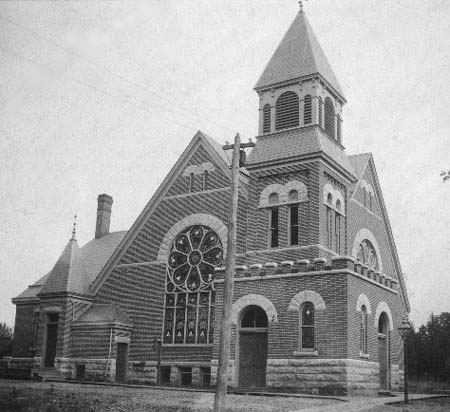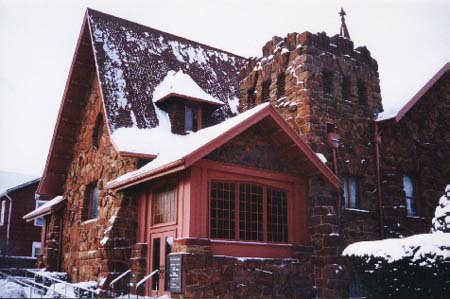inhabitants of Sharon Township made application to the Presbytery of Richland
In the winter of 1828, Rev. George Wolff began to preach occasionally in the
vicinity of Shelby, the services being held in the homes of the people. But
previous to this date Rev. Rowland came from Mansfield with Elder Dillon and
administered The Lord’s Supper in Mr. Smith’s house at Taylor’s Corners. This house,
In the spring of 1829, the “People of Sharon Township renewed their request” for
recognition as a congregation and for preaching. The Presbytery complied with
their wish, “Granting them one-fourth of the ministerial labors of Rev. George Wolff.”
In the spring of 1830 at the request of the people, Rev. George Wolff was
re-appointed as “Stated Supply” for the ensuing year. In the latter part of this
year, or the beginning of the following, the congregation petitioned the
Presbytery to be formally organized into a church; accordingly Rev. George Wolff
was directed to take the necessary steps. Though the meeting for this purpose
was held, March 1831, in their house of worship, a log building situated on what
is now the South-east corner of Gamble Street and Smiley Avenue. Five persons
presented certificates of membership, one was received on profession of faith
and these constituted the church of Sharon as it was then called. Their names
were as follows: John Kerr, John McClinton, Elizabeth McClinton, Aaron Rambo,
Elizabeth Rambo and Leonora May. At the same time Aaron Rambo and John McClinton
an interval from the “original six,” it might not be amiss to give their names.
They are as follows: Jane Kerr, Mary Kerr, William Dickey, Jane Dickey, Cornelia
Kerr, Hulda Smith, Rebecca Cline, Elizabeth Gamble, Margaret Wildon, Nancy
Drake, Mary Wetts, Nancy Fowler, William Kerr, Elizabeth Kerr, Hugh Munell
In 1835 Rev. William Mathews had charge of the church and that year the session
was strengthened by the addition of three members, viz: -Moses Louthan, Jesse
Kerr, and Calvin Clark; the latter’s term of service was exceptionally long,
continuing until his death in 1890.
The Rev. Nathaniel Cobb and Rev. Robert Lee, in order named succeeded Rev. W.
Mathews. From 1838 to 1841 the church had preaching only occasionally. Among the
October 1841, this church united with the church at Rome, Ohio, in extending a
call to Rev. Luther Dodd, each asking for one half of his time. In June
following he was ordained by the Presbytery at Shelby and installed as pastor of
this church. He continued to preach at both churches for six years, after which
time this church took all his time. The coming of Rev. Dodd marked a new era for
the church; his pastorate was the longest it has ever enjoyed, continuing until
the spring of 1852 when failing health compelled him to resign. His pastorate was also
Before Rev. Dodd resigned, another church building, now known as “The Old
Church” on Broadway, was begun, but was not completed before the following year.
To have another house of worship required effort, possibly in some cases, self
denial, but the people faced the work bravely. The Village of Shelby was at this
time still quite small and located entirely on the West Side of the Creek. None of the
During the summer of 1858 Rev. R.R. Moore, then a young man, came upon the
field. In the following year he was ordained by Presbytery and installed pastor
of the church. His pastorate lasted until the fall of 1864. I believe he is
still living and at present preaching for a church in Pennsylvania. But time was
telling on the pioneers, their ranks were thinning and the more than thirty
years since the organization of the church had wrought many changes. In the last
few years the session had lost two of its members by death, Aaron Rambo who was
one of the first two elders of the church and Thomas Clark who been added to the
session later. Owing to these losses there was a need felt for additional elders
and in 1863 W.D. Cook, Daniel Carr and James Jones were chosen to the office.
During these years the church often enjoyed seasons of more than ordinary
spirited interest, although there was no extensive revival. But in the fall of
1865, Rev. J.K. Kost came upon the field and in the following January there was
the largest ingathering the church has ever known at one time. On profession of
faith thirty-six were received and three by letter, and in April following quite
a number more were added. In the spring of 1868 Rev. Kost removed to Plymouth,
Ohio, and is now living at Paola, Fla.
In the early part of 1869, Rev. W.W. Anderson was called as pastor and began his
labors. This pastorate continued until the latter part of the 1876. He is at
present pastor of the churches of Loudonville and Perrysville, Ohio. It was
while Rev. Anderson was laboring here that Edward Johnson, Dr. John Mack and
J.S. Trimble were chosen to the office of ruling elders. “The church contributed
regularly to all our boards and also to the “Million Dollar Fund,” raised as a
memorial of the reunion of the old and new school bodies.
In 1872 a Woman’s Foreign Missionary Society was organized and five years later
the work of the organization was extended so as to include both the Home and
Foreign Missionary fields. For the purpose of extending financial aid to the
church, in 1876 the ladies of the church organized a “Dime Social,” but about ten
After Rev. Anderson left, several efforts were made to secure a pastor, but not
until the summer of 1878 did they succeed, when a call was extended to Rev. J.W.
Thompson who had graduated the previous year at Princeton Seminary. He accepted
the call and continued his labors until the summer of 1885 when he resigned and
removed to Kansas. He is at present pastor of the church at Sterling in that State.
After Rev. Thompson removed Rev. T.C. Thomas preached here for a short time. In
1887 the services of Rev. H.W. Wood were secured. He died in less than a year
and the church remained vacant until April 1889, when the present pastor began
his work. Previous to his coming here a lot has been secured on which to erect a
new church building and some funds had been gradually stored away. Work was
begun on the new building in the fall of 1890. It was dedicated May 1st, 1892,
Rev. A.A.E. Taylor, D.D. preached the dedicatory sermon. The cost of the
building and grounds was $11,000.
 |
 |


Copyright © 2000 - 2024